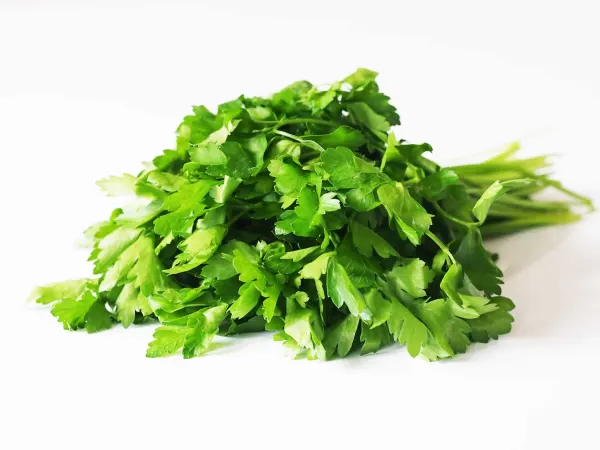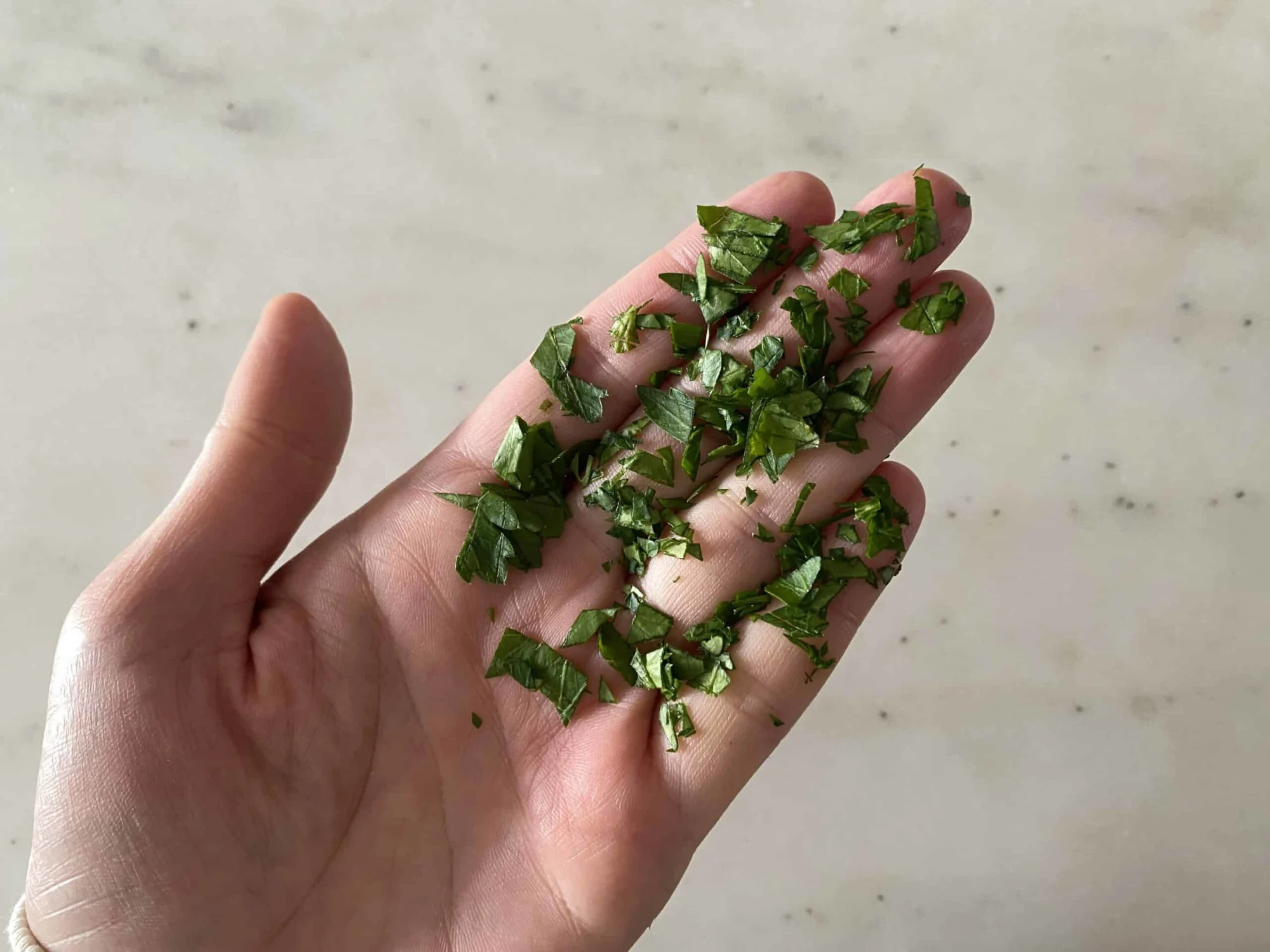Parsley
Herb/Spice
Age Suggestion
6 months
Iron-Rich
No
Common Allergen
No

When can babies eat parsley?
Parsley, if fresh or dried, may be introduced as soon as baby is ready to start solids, which is generally around 6 months of age.
Warning
Never give parsley essential oil or extracts to babies. These products can be toxic, due to their high concentrations of certain plant chemicals that are perfectly safe when consumed in the whole food itself.
Where does parsley come from?
Parsley originated in the fertile lands around the Mediterranean Sea, where the herb has been eaten as food and used in ceremonial practices since ancient times. Like cilantro, the entire parsley plant is edible. Raw leaves are used as a garnish or seasoning, seeds are dried to make spice, and the roots look like parsnips, and can be treated similarly in the kitchen. The leaves are used in dishes across the globe, from green sauces like chimichurri, gremolata, and persillade; to stews like coq au vin, gumbo z’herbes, and ghormeh sabzi; to herb salads like fattoush and tabbouleh. The two most popular types of parsley—curly leaf and flat leaf—can be used interchangeably in cooking, though flat-leaf parsley has a stronger flavor.
Videos
Is parsley healthy for babies?
Yes, although parsley’s nutritional benefits are limited because the herb is often used in small amounts. Parsley leaves contain carotenoids—nutrients such as beta carotene, lutein, and zeaxanthin that promote healthy vision. Babies can also benefit from the vitamin K and vitamin C in parsley, which help build solid bones and healthy tissue. Parsley contains small amounts calcium and iron, as well as a compound called apigenin, which has been studied for its anti-inflammatory and anticarcinogenic properties.
Parsley essential oil or extracts should never be given to babies. These products can be toxic, due to their high concentrations of certain plant chemicals that are perfectly safe when consumed in the whole food itself.
★Tip: Give parsley a good rinse before using, as the leaves may have gained some sand or dirt in harvesting. Parsley is also very perishable, so plan to use it soon after buying. If you have leftover parsley, wrap it in a damp towel and store in a sealed bag in the fridge. You can also blend it with a little olive oil and freeze in ice cube trays for later, or put washed and dried leaves into a freezer bag, remove as much air as possible, and roll the bag up tightly before putting it in the freezer.
Is parsley a common choking hazard for babies?
No. When finely chopped, parsley should not pose any significant risk, although its leaves and flecks can stick to baby’s tongue and roof of mouth and cause some gagging and coughing. If this happens, offer baby a drink from an open cup to help wash it down. Drinking from an open cup (rather than a straw cup) tends to be more helpful in these situations. As always, make sure you create a safe eating environment and stay within an arm’s reach of baby during meals. For more information on choking, visit our sections on gagging and choking and familiarize yourself with the list of common choking hazards.
Is parsley a common allergen?
No. Allergies to parsley are uncommon, although anaphylactic reactions and contact dermatitis have been reported. Individuals who are allergic to the pollen from mugwort or birch trees or who have Oral Allergy Syndrome (also called pollen food allergy syndrome) may also be sensitive to parsley. Oral Allergy Syndrome typically results in short-lived itching, tingling, or burning in the mouth and is unlikely to result in a dangerous reaction.
Although not common, parsley is also a known cause of phytodermatitis, a non-allergic rash that occurs after skin that has come into contact with parsley is exposed to UV light. It is recommended to wash hands and forearms thoroughly after handling or chopping raw parsley.
As you would when introducing any new food, start by offering a small quantity for the first few servings. If there is no adverse reaction, gradually increase the quantity over future meals.
Recommended Guide: Introducing Allergens
How does parsley impact baby's poop?
Because parsley is often used in small amounts, its effects on pooping are minimal. When consuming parsley in larger quantities, such as dishes like tabbouleh, it may help move stool along.
What are recipe ideas for cooking with parsley?
Parsley adds bright flavor to foods in the same way that a splash of lemon juice balances a dish. The herb tastes grassy with a slightly bitter flavor that works well with creamy foods like mashed potatoes, ricotta cheese, or scrambled eggs, but don’t just think of parsley as a garnish. Try parsley leaves in your next salad or smoothie. Add parsley to oil and vinegar to make a marinade for beans, lentils, grains, or mushrooms. Stir parsley into the mix for meatballs, salmon patties, or veggie burgers. Got limited time to cook? You can’t go wrong with parsley, garlic, lemon juice, and olive oil in the classic sauce that tastes delicious with roast meats and vegetables: chimichurri.
How do you introduce parsley to babies with baby-led weaning?
Every baby develops on their own timeline, and the suggestions on how to cut or prepare particular foods are generalizations for a broad audience.
6 to 9 months old:
Blend fresh parsley with oil and a little citrus juice into a bright sauce that can be drizzled onto steamed vegetables, stewed chicken, or poached fish. You can also finely mince parsley to fold into soft, scoopable foods like mashed vegetables, rice, or yogurt. Exposing baby to flecks of green early on helps acclimate them to green foods and foods that are mixed together.
9 to 12 months old:
Incorporate finely minced parsley into sauces, meat patties, and lentils, or sprinkle on top of bean dishes and steamed vegetables. And by all means, continue to use parsley to make green sauces to season baby’s food.
12 to 24 months old:
Use parsley as you normally would in dishes, even if a recipe calls for whole parsley leaves. Just keep in mind that any larger leaves may cause toddlers to gag or cough a little. Keep an open cup with water or milk on hand and encourage the toddler to take a sip if a bit of parsley gets uncomfortable.

Explore recipes for the whole family that are safe for babies with our guide, 100 Dinners for Babies & Toddlers.
Written and reviewed by these specialists
E. Cerda, MSN, CNS, LDN
A. Gilbaugh, RD, CNSC
K. Grenawitzke, OTD, OTR/L, SCFES, IBCLC, CNT
Dr. S. Bajowala, MD, FAAAAI. Board-Certified Allergist & Immunologist (allergy section)
Dr. R. Ruiz, MD, FAAP. Board-Certified General Pediatrician & Pediatric Gastroenterologist
Expert Tips Delivered to Your Inbox
Sign up for weekly tips, recipes and more!
The content offered on SolidStarts.com is for informational purposes only. Solidstarts is not engaged in rendering professional advice, whether medical or otherwise, to individual users or their children or families. No content on this site, regardless of date, should ever be used as a substitute for direct medical advice from your doctor or your medical or health professional, nutritionist, or expert in pediatric feeding and eating. By accessing the content on SolidStarts.com, you acknowledge and agree that you are accepting the responsibility for your child’s health and well-being. In return for providing you with an array of content “baby-led weaning” information, you waive any claims that you or your child may have as a result of utilizing the content on SolidStarts.com.


